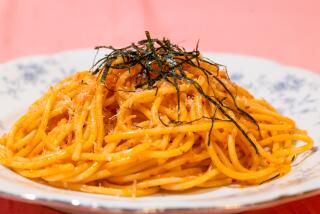There’s More Than One Catch to This Paella : In fideua, pasta replaces the essential ingredient in a variation of the popular Spanish dish.
- Share via
The star of Spanish cooking is paella. Indeed, a recent trip to Madrid revealed how firmly established this Valencian rice dish is in Spain’s culinary pantheon. I sampled seafood paellas and poultry paellas; golden paellas emblazoned with saffron and black paellas darkened with squid ink; single-portion paellas served at tapas bars and jumbo paellas big enough for a whole neighborhood, cooked in five-foot pans.
But the most interesting paella I tasted on my trip wasn’t really paella. It lacked the one ingredient most of us think of as essential to paella: rice. It’s called fideua and is made with pasta and seafood, not rice.
Once the province of homey seaside eateries, fideua has become the star attraction of the Sunday brunch at Madrid’s Ritz Hotel. Its preparation is the responsibility of a Valencian cook named Francisco Gonzales, who has worked at the Ritz for 20 years. Gonzales has the sort of intensity and economy of motion you find in people who spend most of their waking hours in kitchens. He never quite stops moving, but neither does he waste or duplicate a gesture. I have the sense he’d be equally comfortable making fideua for two or 200.
According to Gonzales, fideua originated in Valencia. Other authorities cite the Costa Brava in southeast Spain as its birthplace. Etymology would suggest the latter: Fideua takes its name from fideos, the traditional pasta of Catalonia. Fideos look like short (1-inch) curved pieces of spaghetti. They can be as fine as angel hair or as thick as buccatini.
If you live in an area with an Iberian market, you may be able to find fideos. If not, you’ll need to use regular spaghetti and break it into 1-inch pieces. Don’t try to do this with the whole package at once. Break a dozen or so strands at a time. You can also made fideua with orzo or even slender macaroni.
The next thing you’ll need is seafood. Legend has it that fideua was invented by thrifty fishermen as a way to use up unsold catch at the end of the day. Today, most versions would contain at least four types of seafood: shrimp, scallops, clams or mussels and some sort of fish, like hake or monkfish. I let my ingredient list be guided by what looks best at the fish market. Feel free to substitute other seafood for the items called for below.
You’ll also need fish stock, which Gonzales brews daily in a giant stockpot. But don’t let the lack of homemade fish stock stop you. I’ve made fideua with chicken stock and also used bottled clam broth, which is available at any supermarket. If you use bottled clam broth, reduce the salt.
Last, you’ll need saffron. Saffron consists of the stigmas of an intensely fragrant Iberian crocus. The labor involved in plucking the stigmas from the flower, one by one, by hand, makes it the world’s most expensive spice. Fortunately, a little goes a long way. The expense makes it an easy target for unscrupulous vendors who sell adulterated or fake saffron at bargain prices.
To make sure you’re getting the real McCoy, buy saffron threads, not powder. The merest whiff should set you dreaming about the Mediterranean. Saffron is available at most supermarkets and gourmet shops, but you may need to ask for it at the office, where some store managers keep it safe from shoplifters.
FIDEUA
10 ounces thick spaghetti or buccatini (about 2 cups of 1-inch pieces)
2 tablespoons olive oil
1 onion, chopped fine
2 cloves garlic, minced
3 large tomatoes, peeled, seeded and chopped fine
1 teaspoon paprika
12 small clams or mussels, scrubbed under cold water
6 ounces shrimp, peeled and deveined
6 ounces scallops (large ones cut into quarters, small ones cut in half or left whole)
1/2 pound monkfish or other firm white fish, cut on the diagonal into 1/2-inch slices
2 1/2 to 3 cups fish or chicken stock or bottled clam broth, or as needed
1/4 teaspoon saffron threads, soaked in 1 tablespoon warm water
Salt Freshly ground black pepper
2 tablespoons chopped fresh parsley for garnish
Holding few strands at a time, break pasta into 1-inch pieces and set aside.
Heat oil in paella pan or large skillet. Add onion and garlic and cook over medium heat until soft and translucent but not brown, about 4 minutes. Add tomatoes and paprika and cook until all liquid has evaporated, about 5 minutes.
Stir in clams, shrimp, scallops and monkfish and saute 1 minute. Add 2 1/2 cups fish stock and saffron and bring to boil. Stir in pasta and bring to boil. Reduce heat and gently simmer until pasta is cooked, 15 to 20 minutes, stirring occasionally. If mixture dries out too much before pasta is cooked, add remaining stock. Add salt and pepper to taste. Sprinkle with parsley and serve at once.
Makes 4 servings.
More to Read
Eat your way across L.A.
Get our weekly Tasting Notes newsletter for reviews, news and more.
You may occasionally receive promotional content from the Los Angeles Times.










